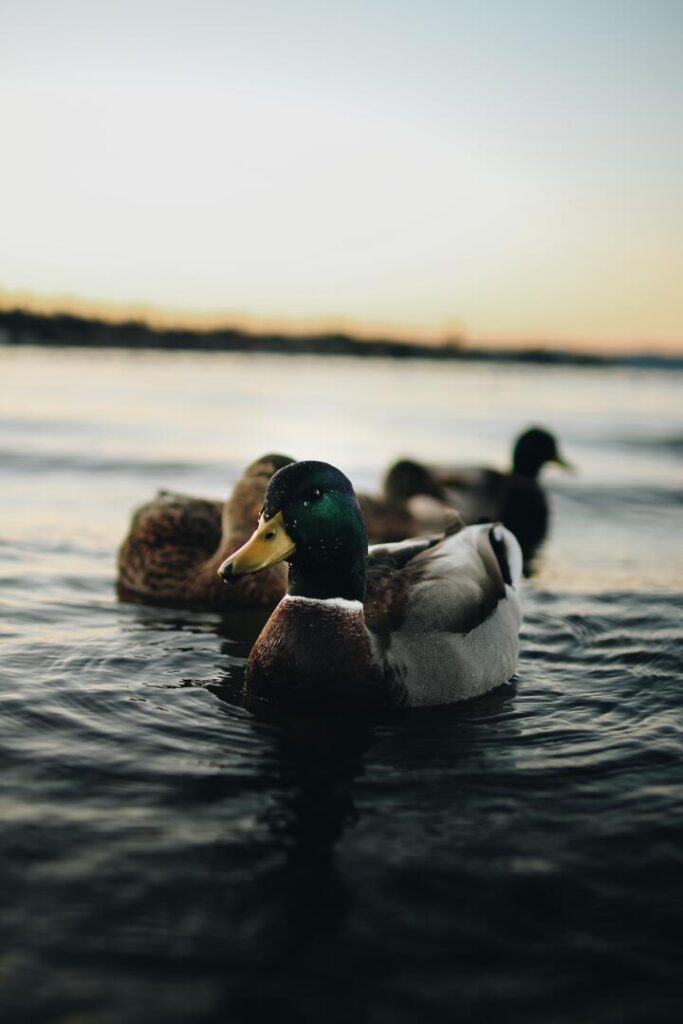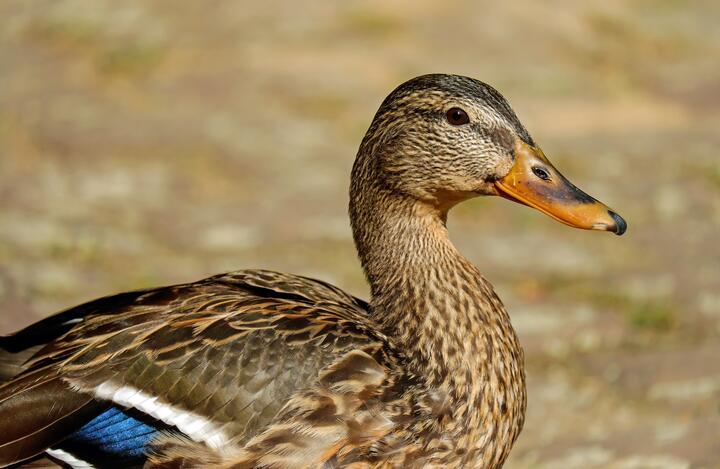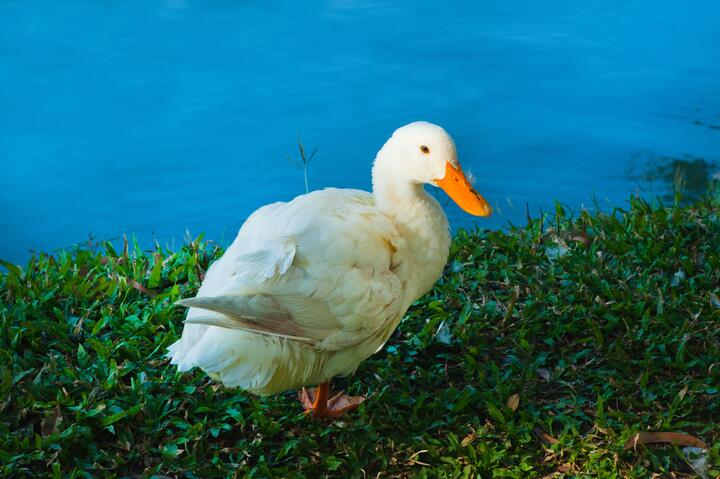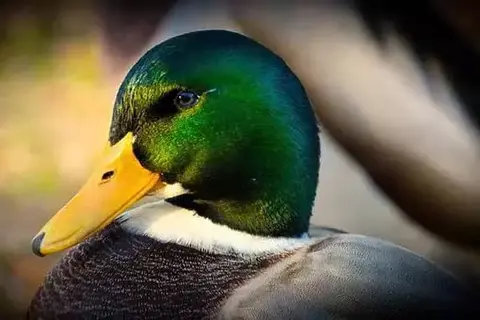Ducks are omnivores, but this doesn’t mean they can eat anything. Some foods can be harmful, and well-meaning actions can lead to unintended consequences. While walking near reservoirs, you might see people tossing bread into the water to feed the ducks. However, during the warm season, these birds typically find ample food on their own. In the wild, ducks primarily consume plant-based foods. Their diet includes various aquatic plants like duckweed, algae, and grasses along the shoreline.
Although pond ducks prefer plant foods, they also eat small animals found in the water, such as fry, worms, tadpoles, mollusks, and larvae. They even prey on small fish and young frogs. Wild ducks are particularly drawn to urban water bodies because they feed on mosquito larvae by foraging in shallow waters. From observing their natural diet, it’s clear that wild ducks consume a lot of protein and fiber. As fall approaches, their diet shifts to include grains, which they gather from harvested fields and wild grain sources.

Mallards are the most frequently seen ducks in various water bodies, and they have grown so accustomed to human presence that they will confidently eat from people’s hands.
However, feeding them bread is a bad idea. Bread crumbs can contaminate the water and promote the growth of cyanobacteria. When you see a mallard drake or female eagerly approaching for food, it’s natural to wonder what is safe to give them. Many people, with good intentions, end up tossing unsuitable food items into the water, not realizing the potential danger.
Caution! Instead of harmful bread, consider bringing fiber-rich foods to feed the ducks. Good options include rice, zucchini, eggplant, beets, corn, lettuce, cat and dog kibble, tomatoes, cucumbers, cabbage, and millet.
Unveiling the Diet of Wild Ducks: What Do They Really Eat?
The mallard is the largest and most prominent duck found in city ponds, and they are often the most numerous. These ducks are so accustomed to humans that they sometimes take food directly from people’s hands.
In their natural habitat, mallards, like other waterfowl, primarily consume plant-based foods. Their diet mainly includes aquatic plants such as algae, duckweed, and moss, as well as grasses along the shores of water bodies. In the autumn, they often visit harvested fields to gather leftover grains.
While dabbling in the water, mallards also feed on a variety of aquatic animals, including:
- Mollusks
- Juvenile fish
- Tadpoles and frogs
- Invertebrates living in the silt and wet soil along the shore (such as worms, beetles, and larvae)
During the frog breeding season, amphibian eggs become part of their diet.
The diet of wild mallards is rich in plant fibers and protein, with seeds from wild grasses and cultivated plants comprising a small portion. In winter, wild ducks migrate to areas with shallow, ice-free waters where they can find familiar food sources.
Debunking the Bread Myth: Is it Safe to Feed Wild Ducks?

More and more often, migratory birds stay for the winter in the same urban ponds where they spend the summer. This is partly because winters have become warmer and ponds for ducks in the park are practically not frozen. But it is much more common for wild ducks to stay in the city for the winter because of the availability of food.
They get used to getting food from people who actively feed the supposedly starving birds. Indeed, the ducks greedily rush after every piece of bread and even fight over food. But this instinctive behavior is still formed at the chick’s age when the survival of the ducklings depends directly on the ability to compete. In summer, there is enough food for the feathered birds even in a relatively clean city pond. If necessary, the birds would fly away to abundant feeding places.
For their own entertainment, vacationers throw pieces of bread, cakes, or buns to the waterfowl. The ducks react with interest to the new object, tasting it. Finding that it is edible, they actively eat the offered food, which they do not need to get on their own. People interpret the birds’ attention to a piece that has fallen into the water as a sign of hunger and start purposefully feeding them.
But a mass containing minimal fiber, fat, yeast, and a lot of salt is very poorly digested by the duck’s stomach. The bread swollen in the digestive system is hardly processed by the GI tract and excreted very slowly, preventing the ducks from eating properly. Rye varieties of bread pose a real danger to duck health. Causing fermentation processes in the intestines, this food poisons the body.
But the most terrible consequence of feeding wild birds is their reluctance to fly away for the winter from places where food can be obtained at any time and without difficulty. In the wilderness, the signal to start migrating is not only the length of daylight hours but also a decrease in the amount of available food. At the pond within the city limits, where holidaymakers feed the ducks until winter, the birds do not feel the need to migrate.
When cold weather arrives, when there are fewer feeders and the pond shoreline is covered with ice, the ducks can no longer fly anywhere. Surveying the surrounding areas, they find no acceptable conditions for the existence and return to their pond. When severe frosts hit, some of the birds die by freezing into the ice or become prey to stray dogs. And even in warm winters, they may get really hungry, unable to get food in the shallow water near the shore.
Nourishing Ducklings: A Guide to Feeding Baby Ducks
If you find yourself caring for a wild duck chick, ensuring it receives proper care and nutrition is essential. Fortunately, ducklings are typically robust and capable of foraging for their own food from an early age, so you shouldn’t encounter many difficulties.
Here’s what wild ducklings eat during their early stages of development. If the chick is newly hatched and hasn’t yet developed its feathers, it’s usually just a few days old. At this stage, it’s recommended to feed it boiled and finely chopped eggs. As the chick grows older, you can gradually introduce finely chopped grass and defatted cottage cheese into its diet.
Once the duckling has developed its down feathers, you can start incorporating pre-crushed cereals into its meals.
Around ten days old, you can begin adding boiled root vegetables and finely chopped herbs to the chick’s diet. However, ensure that the food isn’t too liquid as the chick may struggle to clean its beak from dried food residues at this stage.
Once the duckling has fully transitioned from down to feathers, you can gradually introduce it to the diet of adult ducks. This ensures a smooth transition to a more varied diet as the duckling matures.
Pond Gourmet: Unlocking the Culinary World of Ducks’ Natural Diet

When it comes to what ducks eat in a water pond, it’s not always just fish. While ducks are indeed predators, their diet encompasses a variety of foods, including insects, so it’s not uncommon to see them foraging for various items. To delve deeper into the dietary habits of different duck species, you might find the following articles insightful.
Ducks primarily consume aquatic plants such as millet, corn, and other vegetation. Additionally, they feed on small fish, snails, frogs, and insects. Domestic ducks particularly enjoy algae, fish, and other small aquatic creatures. If you maintain a pond with a diverse plant population, you can supplement their diet with these plants.
Maintaining clean water is crucial when feeding ducks, as most species cannot feed in water deeper than two feet. However, geese, with their thicker skins, can handle deeper waters and also enjoy berries and citrus fruits. It’s essential to provide a balanced diet for them, including both plant matter and protein sources.
Considering what ducks eat, crayfish are a staple in their natural diet. However, they also relish cooked vegetables like sweetcorn and lettuce. Leftovers can also be a treat for them if you don’t have access to a pond.
While their diets may vary slightly, ducks will eat various foods, including those intended for household pets like dogs or cats. They might even consume worms found in the water. However, it’s crucial to avoid feeding them dog or cat food to prevent aggression. Instead, provide a natural environment where they can thrive and find food sources.
While ducks can consume a wide range of foods, they thrive best when provided with their preferred diet. They won’t starve if they can’t access their favorite foods regularly. Supplementing their diet with birdseed or bread can help maintain their health and happiness.
The specific food preferences of ducks vary depending on their species. For instance, Little Call ducks tend to consume more plants, while Appleyard ducks mainly graze on vegetation. However, aquatic plants remain a staple in most ducks’ diets, supplemented by occasional fish.
In summary, while aquatic plants are a primary food source for ducks in ponds, they also consume fish and a variety of other living organisms. Providing a balanced diet ensures their health and well-being, and incorporating diverse food sources contributes to a thriving duck population.
